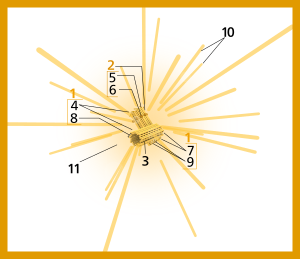Centriole
| Cell biology | |
|---|---|
| The centrosome | |

Components of a typical centrosome:
|
In cell biology a centriole is a cylindrical cell structure composed mainly of a protein called tubulin that is found in most eukaryotic cells. An associated pair of centrioles, surrounded by a shapeless mass of dense material, called the pericentriolar material, or PCM, makes up a compound structure called a centrosome.
Centrioles are present in the cells of most eukaryotes, for example those of animals. However, they are absent from conifers (pinophyta), flowering plants (angiosperms) and most fungi, and are only present in the male gametes of charophytes, bryophytes, seedless vascular plants, cycads, and ginkgo.
Most centrioles are made up of nine sets of microtubule triplets, arranged in a cylinder. Deviations from this structure include crabs and Drosophila melanogaster embryos, with nine doublets, and Caenorhabditis elegans sperm cells and early embryos, with nine singlets.
Edouard van Beneden and Theodor Boveri made the first observation and identification of centrioles in 1883 and 1888 respectively, while the pattern of centriole duplication was first worked out independently by Etienne de Harven and Joseph G. Gall c. 1950 The main function of centrioles is to produce Cilium during interphase and aster and spindle during cell division.
...
Wikipedia
